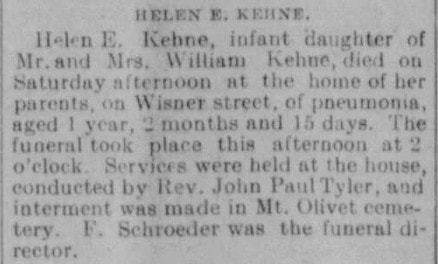Kehne Children Monuments
Location: Area L/Lot 36
Date of Placement: after 1902
Decedents: Helen E. Kehne, Blanche M. Kehne, John Edgar Kehne, Pearl C. Kehne
Monument inducted into the Hall in September 2022 (Class #3)
Location: Area L/Lot 36
Date of Placement: after 1902
Decedents: Helen E. Kehne, Blanche M. Kehne, John Edgar Kehne, Pearl C. Kehne
Monument inducted into the Hall in September 2022 (Class #3)
There are many cemetery symbols of iconography that seem to be ubiquitous—the lamb is certainly one of them. When traversing a graveyard, if you see a tiny lambs on a stone, you most likely have the grave of a child. These lambs come in many sizes and positions—usually you will find these straddling small tombstones or foot stones.
The lamb is the symbol of the Lord, the Good Shepherd. The animal also represents innocence, likely the reason for this motif commonly adorning the tombstones of infants and young children. Most often the lamb is lying down, often asleep and sometimes with a cross incorporated in..
The lamb is the symbol of the Lord, the Good Shepherd. The animal also represents innocence, likely the reason for this motif commonly adorning the tombstones of infants and young children. Most often the lamb is lying down, often asleep and sometimes with a cross incorporated in..
In a few places within Mount Olivet, one can find clusters of graves topped by lamb monuments. Area L is one of these, and boasts four such monuments (topped by this animal) in the family plot of William Richard Kehne (1879-1945). Kehne worked as an engineer with the Ox-Fibre Brush Company located on East Church Street extended. He married Blanche Virginia Cutsail and the family welcomed their first child in 1907. He was named William Cutsail Kehne in honor of both parents.
The family lived nearby William's worksite, residing on Wisner Street in the 1910 Census, and at 501 East Church by the 1920 Census. During the teens decade in between, the Kehnes would gain three more members, but lose four. These children constitute the row of lamb-topped gravestones that have been chosen for Hall of Fame induction. The four are shown below. Please note that Helen Kehne passed first, and a different marble mason/company appears to have been employed by the family as the sheep, shape of dye, design and vital information is completely different than the other three.
The family lived nearby William's worksite, residing on Wisner Street in the 1910 Census, and at 501 East Church by the 1920 Census. During the teens decade in between, the Kehnes would gain three more members, but lose four. These children constitute the row of lamb-topped gravestones that have been chosen for Hall of Fame induction. The four are shown below. Please note that Helen Kehne passed first, and a different marble mason/company appears to have been employed by the family as the sheep, shape of dye, design and vital information is completely different than the other three.
It goes without saying that the loss of a child is excruciatingly difficult for any parent to deal with. This couple dealt with the loss of four children over a seven-year span. One is too many for most to deal with, but this was a a time a century ago when children mortality washigh and medicine was not what it is today. As you just read, the Kehne children died of such maladies as pneumonia, infant cholera and meningitis. These can be handled more routinely by the physicians of today, and the highly improved treatments and recovery regiments currently available.
I'm sure the Kehnes cherished their three remaining children (William, Arthur and Thelma) who would grow into adulthood. It's a sad thing to see those small groupings of baby sheep at a cemetery. This is just one more example. God bless, and hold, parents such as William R. and Blanche Kehne. Those who endure (and survive) the loss of a child are certainly the strongest among us.
I'm sure the Kehnes cherished their three remaining children (William, Arthur and Thelma) who would grow into adulthood. It's a sad thing to see those small groupings of baby sheep at a cemetery. This is just one more example. God bless, and hold, parents such as William R. and Blanche Kehne. Those who endure (and survive) the loss of a child are certainly the strongest among us.










